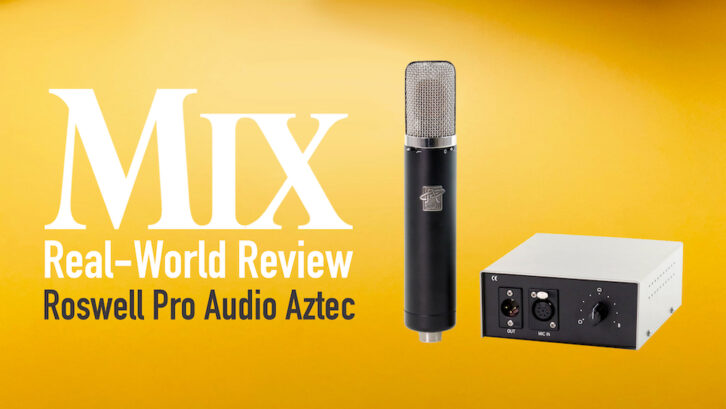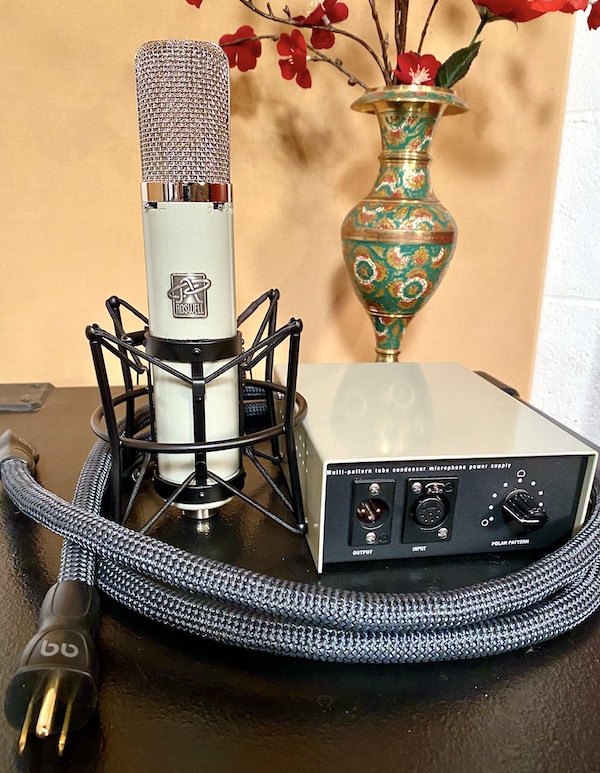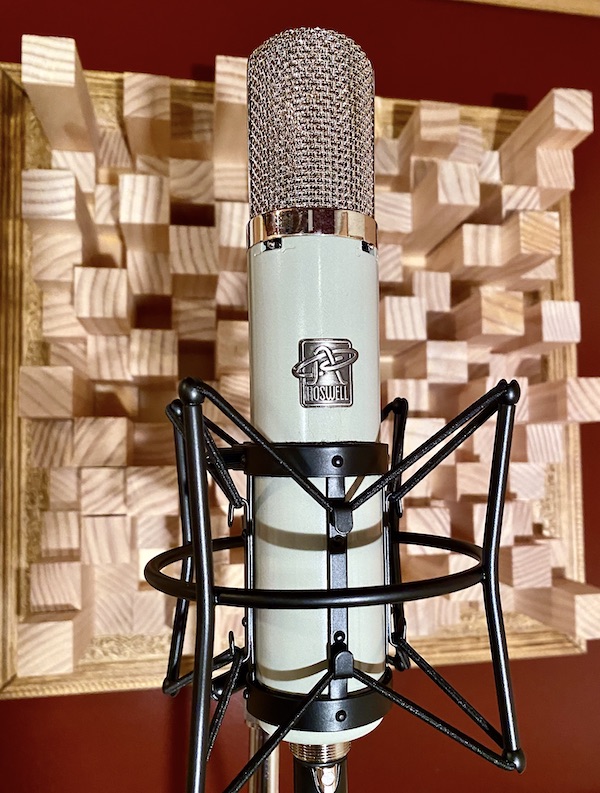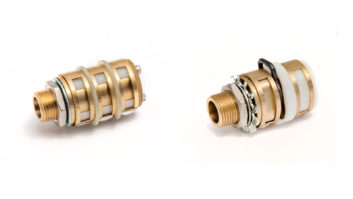
| MIX VERDICT: ROSWELL PRO AUDIO AZTEC MICROPHONE |
| THE TAKEAWAY: “The Aztec is a mic with a personality—an eminently likable one—but with an attitude and response that more often than not solves problems.” |
| COMPANY: Roswell Pro Audio • www.roswellproaudio.com PRICE: $$2,999 MSRP PROS: • Smoothly musical tone • Excellent components and design • Reasonably priced CONS: • Colorful personality requires some experimentation |
Tube mics. They often have a certain palatable smoothness to their high-end response, a flattering containment of the quick peaks and a sense of completeness to their midrange response, the low-mids in particular. The new Aztec tube mic from Roswell Pro Audio exhibits all of the above properties, as it was meticulously designed and built. It’s not exactly low-cost, but it is a bargain for a mic of this pedigree and ability.

The Aztec ships with the microphone itself, an elastic-based shock mount, Gotham GAC7 cable (terminated with Neutrik connectors), power supply, AudioQuest power cord, storage bag and flight case. The mic and its power supply boast a number of carefully chosen components that Roswell founder Matt McGlynn selected after years of extensive testing and experimentation. The end result is a unique, all-new mic with a richly classic sound, perhaps reminiscent of a classic ELA M 251 but by no means a clone.
The Aztec uses a single-triode 6072 tube, with a K251-type edge-terminated capsule, a custom-wound T-14-type transformer (like those found in certain classic AKG models), high-grade capacitors (an extremely transparent NOS military-spec input capacitor and proprietary copper-foil output cap), and components selected to reduce noise. The mic’s chassis has a -10 dB pad switch and a high-pass filter (-3 dB at 140 Hz).
The power supply houses a nine-pattern selector switch with cardioid, figure-8 and omnidirectional patterns, as well as three intermediate positions between those patterns. The mic has a chrome head basket, and the body is currently available in cream or black, with a color-coordinated power supply.
McGlynn placed particular emphasis on the regulated power supply design (a necessity so the tube circuit does not starve or behave irregularly during power fluctuations), which utilizes proprietary electrolytic filter caps, NOS tantalum resistors, vintage Telefunken diodes, audiophile-grade resistors, Kimber solid-core wiring, a Swiss-made pattern selector, and an IEC power cord of the “over-built” variety that many engineers question the necessity of.
Says McGlynn, “[It’s] not because we think anyone would hear an upgraded power cord, but because shipping a 75-cent plastic IEC cable to accompany a microphone where we made no other compromises in the signal path seemed absurd.”
IN SESSION
My workload these days centers on vocal recording with a bit of everything else under the sun, so naturally I started tracking some vox with the Aztec. I was relieved to find that the shock-mount brackets securely clamp the mic with bolts, holding it firm— perhaps a little cumbersome for frequent mic re-positioning, but worth the trouble for the security. With a rapper in the booth, I opted for the cardioid pattern, with the most focused and tight sound (a necessity for modern rap).
This particular rapper has a very deep voice with not quite enough articulation, so I routinely use a bright mic on him, often with further high- and high-mid boosts in the mix to get that ridiculously crisp vocal tone that is “du jour” these days. Here, the Aztec proved to be “a little dark and thick tonally”—the only time during numerous tests I was able to utter that tube mic cliche.

Next up was a run of conventional singers, both male and female, loud and soft, aggressive and mellow, and the Aztec shined for them all. For many tracks, the “cardioid with one click toward omni” setting was ideal for a focused tone with just a touch of softness and ambient air—absolutely perfect for “hard” singers with tough transients and excessive mouth noise, as this setting seems to gently soften such issues.
I found the high-pass filter to be useful on all male singers, and I only defeated it for the thinnest-voiced of female vocalists. I feared that 140 Hz was a bit high in frequency, but I was wrong (it is a gentle slope, after all). I never needed the -10 pad for any vocals.
With two- and four-vocalist sessions, I found myself using figure-8 and omni, respectively, with excellent results. No worries about hollowness in figure-8 or directionality in omni (or blandness for that matter), as the Aztec was fantastic in both patterns. Furthermore, in omni, one click toward cardioid was a wonderful setting for both whispered vocals and aired-out, roomy tones, with reduced proximity effect and a very natural soundstage.
Speaking of room tones, once I put the Aztec up in the air for drum duty, I couldn’t take it down! The kit balance was only a little bright for room placement (where I’m primarily seeking low-mid fullness), but spot-on perfect as a third overhead. There’s plenty of punch, a euphonic sense of detail and a soundstage that seems larger than solid-state microphones.
BRING ON THE GUITARS
However, I didn’t really “know” the Aztec until I tested it on acoustic guitar. I tried both the at-the-neck-juncture and the on-the-body positions and really liked the tone of both.
At the neck, the slight reduction of spiky, excessive transients was welcome and dutifully tamed, while the extremely balanced frequency response needed no EQ (maybe a slight dip in the mids depending on the instrument or key). On the body, the Aztec produced a rich and visceral low-midrange that captured more musicality and “power” than my usual solid-state selections— not dull and murky, just warm and substantial. The typically dreadful job of acoustic lead parts on a parlor guitar found the Aztec translating better than the reality, with musicality and a perfect amount of attack.
Emboldened with success, I slapped the Aztec right smack in front (as close as possible) of a raging guitar cabinet with various vintage Marshalls, Fenders and Vox amps. Sometimes I needed the pad, sometimes not, but no matter— what a killer guitar tone! Yes, there was enough high end, but the operative difference was those low-mids again. Those sometimes troublesome frequencies had abundance but also a certain musicality that works nicely in a mix and lends heft to an area that we often carve out for cooperation with bass guitar and the left-hand of keys.
If you track lots of percussion (tambos, shakers, claves, cajon, djembe, etc.), you will likely find the Aztec indispensable, as it tames the unwanted detail in the sharp stuff and lends gravitas to all the slappy stuff. Tracks that typically would have to be EQ’d like crazy needed little or no EQ (maybe some mid-dipping) and seemed to require less compression/limiting in order to sit politely in a mix.
Neumann MT 48 Interface – A Mix Real-World Review
I was hoping the Aztec would be the solution to tracking doghouse bass, but my tests were inconclusive. Great acoustic bass tracks seem to require total synergy: a fine instrument, a neutral preamp, a mic (or mics) with wide frequency response and accurate transient detail, a well- tuned room, and an expert player, but I couldn’t grab the perfect mix tone this time around.
To my chagrin, I never got to track horns, organ or bluegrass instruments (mandolins, banjos, dobros, ukuleles, etc.), and boy, do I wish I could have. It’s only informed conjecture, but I’ll bet the Aztec would solve my love- hate relationship with bluegrass instruments, as Aztec’s dynamics taming and frequency response seem like a perfect fit for such challenges (not unlike that parlor guitar).
All told, other than my mumble rapper, I never did find an app that the Aztec did not excel at. Though often brighter than I expected, I didn’t do as much compensatory EQ as I usually would (sometimes notched for nasal-ness, sometimes hi-mid boosts for clarity), but when I did, I found that boosting EQ was smoother than typical and musical—even if the frequencies weren’t my “usuals.”
THE FINAL MIX
All things considered, the Aztec is a mic with a personality—an eminently likable one—but with an attitude and response that more often than not solves problems rather than exacerbates them. The Aztec is not a neutrally transparent transducer, as it lends color and interpretation; with a little curiosity and experimentation, you may find that it opens up new tones that solid- state models and modeling can’t quite achieve.
Yes, the $3k price tag can be a shocker at first glance, but compared to other modern and similar vintage offerings, the buy-in is actually very competitive. This price defines the Aztec as an investment (not a whim), and a wise one, as modern designs and components are likely to result in less maintenance issues and performance irregularity in the long run.







